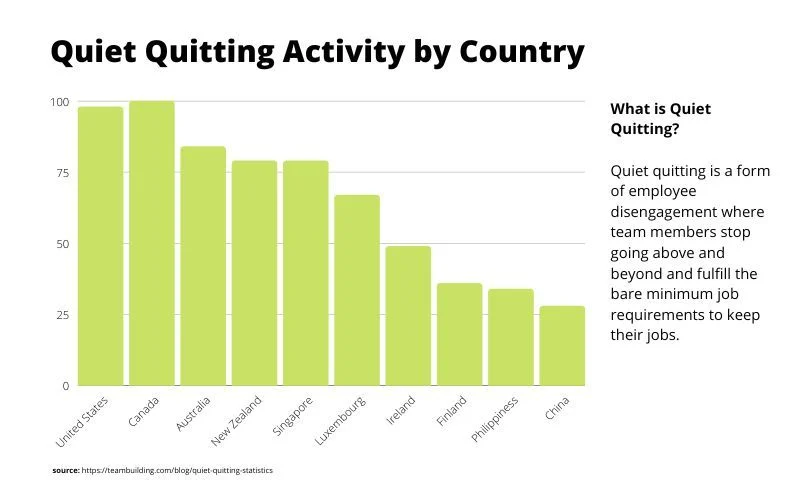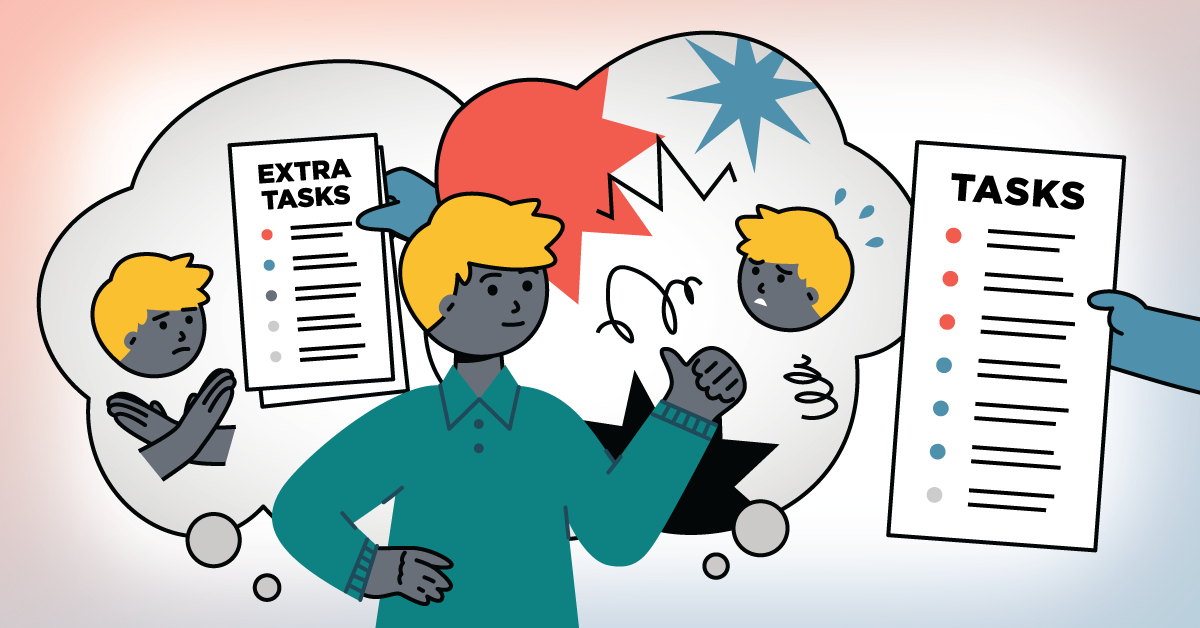Introduction
The wave of people leaving their jobs over the past several years shows no sign of letting up, and for those who choose to quit, a massive re-evaluation of their work values and expectations has begun.
While the pandemic was the catalyst for the great resignation, the phenomenon continues to manifest in different shapes and forms. According to the U.S. Bureau of Labor Statistics, 4.4 million Americans quit their jobs in July 2021.
Roughly a year later, the term “quiet quitting ” emerged from a viral TikTok video and has since been recognized as a global phenomenon that has employers concerned. An August 2022 survey conducted by ResumeBuilder.com found that nearly 21% of working Americans are self-described quiet quitters.
The quiet quitting trend continues to snowball on social media, particularly TikTok, where the #QuietQuitting hashtag has amassed almost five million views.
In this blog, we explain what quiet quitting is, identify the reasons for its existence and what employers might do to address and adapt to the phenomenon.
What is quiet quitting?
Quiet quitting is a workforce trend where employees have decided to do the bare minimum work required by their employer. For instance, a typical quiet quitter works 40 hours a week and only completes mandatory tasks. Work that isn’t finished is left for the next day regardless of urgency.
A 9:00-5:00 quiet quitter starts at exactly 9:00 am, takes all of their breaks, a full lunch, and leaves at exactly 5:00 pm. If the phone rings, they are unlikely to answer it before 9:00 am, during breaks or lunch, and certainly not after 5:00 pm. That includes emails as well.
Interestingly, as of August 2022, Wikipedia has started a brand new page defining the quiet quitting phenomenon. It reads:
“Quiet quitting is a term and a trend that emerged in mid-2022 from a viral TikTok video. The philosophy of quiet quitting is not abruptly leaving a job but doing exactly what the job requires, no more, no less. The main objective of this mindset is avoiding occupational burnout and paying more attention to one’s mental health and personal well-being.” –Wikipedia

Why has quiet quitting become a workplace trend?
The phenomenon is still in the early stages, so a full explanation is on going. However, we do know that individual reasons for quiet quitting are linked to a lack of job satisfaction and general employee disengagement.
Examples of quiet quitting range from employee burnout to conflicting interests between professional and personal priorities and/or a general lack of recognition by employers when employees go above and beyond the call of duty.
Dr. Ashley Weinberg, University of Salford, summarizes quiet quitting as a violation of the psychological contract between employee and employer. She argues:
“If you’re committed to your career and feel an emotional bond with the organization or the career, then if an event happens that violates the psychological contract, the unwritten expectations, that abuses our sense of whether we can trust the organization,” – Dr. Ashley Weinberg, University of Salford

Here are a few quotes that help to capture the individual thoughts/feelings surrounding quiet quitting:
- “To me, quietly quitting just comes back to setting your boundaries about what your outputs are going to look like at work,” – Daniella Flores a 32-year-old IT professional & entrepreneur.
- “Quiet quitting is allowing yourself to put other things before work without feeling bad about it,” – Clayton Farris, a 41-year-old freelance writer.
- “Quiet quitting is a survival tactic… It’s a coping mechanism.” – Maggie Perkins, a 30-year-old high school teacher.
The underlying beliefs fueling quiet quitting and the great resignation are in stark contrast to the hustle culture mentality that prioritized work and organization over everything else. The idea was that hard work made employees more desirable to their companies, facilitating career advancement and increases in salary and benefits.
In short, these global phenomena have employees re-evaluating their values to match their attitudes and beliefs toward their organization, jobs, and careers. To quietly quit is the embodiment of employees’ desire for their organizations to recognize healthy boundaries and champion work-life balance.
What can employers do to adapt to the quiet quitting trend?
- Organizational leadership needs to find ways to get the quiet quitters re-engaged. Thus, managers must actively implement ideas and practices that make the workplace as enjoyable and stress-free as possible. When a person is happy in their job and is fulfilled by their contribution, the employee will thrive and is less likely to leave.
- Employers must recognize when employees stay late, come in on off-days, or do work outside their regular responsibilities. Recognition helps employees see that their company values them and their contributions to the organization’s success.
- Organizations must be sensitive to increases in the cost of living, such as inflation. In addition, if staying late, bringing work home, coming in on weekends, or taking on extra tasks adds to the employee’s relative costs such as, daycare expenses, commuting costs, or time spent away from family, it must be reimbursed. If additional work and expenses continue over the long term, employees will start questioning why they are going above and beyond their job description.
Note: Doing more work for the same pay will cause resentment, and eventually, employees will resist. This is the new norm, these are work values that define this decade.

Here are some questions to help employers begin the discussion with their team:
- How can employees achieve a healthy work-life balance?
- How can we effectively monitor mental health and emotional well-being?
- How can we redesign tasks and projects, so they are not overwhelming?
- How can we help offset inflation and increases in the cost of living?
- Is there a way to improve time-off policies?
- How can we increase productivity while re-defining personal & professional boundaries?
- What can we do to ensure that you (the employee) stay with the company?
Thank you for reading our article!
TimeWellScheduled.com is a secure, online time and attendance software that is 100% tailored to meet your scheduling needs! In addition, TimeWellScheduled facilitates employee attendance tracking & payroll tasks and enhances your staff management capabilities. Plus, our Service is free for up to 10 employees!
Click: here to download our (Excel) employee scheduling template; IT’S FREE!





